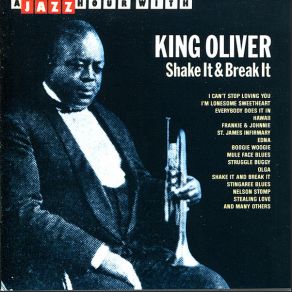A Jazz Hour With King Oliver: Shake It & Break It
Download links and information about A Jazz Hour With King Oliver: Shake It & Break It by King Oliver. This album was released in 1996 and it belongs to Jazz genres. It contains 22 tracks with total duration of 01:07:29 minutes.

|
|
|---|---|
| Artist: | King Oliver |
| Release date: | 1996 |
| Genre: | Jazz |
| Tracks: | 22 |
| Duration: | 01:07:29 |
| Buy it NOW at: | |
| Buy on iTunes $7.99 | |
| Buy on Amazon $7.99 | |
Tracks
[Edit]| No. | Title | Length |
|---|---|---|
| 1. | I Can't Stop Loving You | 2:50 |
| 2. | I'm Lonesome Sweetheart | 2:46 |
| 3. | Everybody Does It In Hawaii | 2:57 |
| 4. | Frankie & Johnnie | 3:13 |
| 5. | St. James Infirmary | 3:40 |
| 6. | Edna | 2:43 |
| 7. | Boogie Woogie | 3:07 |
| 8. | Mule Face Blues | 2:54 |
| 9. | Struggle Buggy | 3:01 |
| 10. | Olga | 3:26 |
| 11. | Shake It and Break It | 2:32 |
| 12. | Stingaree Blues | 3:11 |
| 13. | Nelson Stomp | 3:11 |
| 14. | Stealing Love | 3:21 |
| 15. | Papa-De-Da-Da | 2:55 |
| 16. | Who's Blue | 2:57 |
| 17. | Stop Crying | 3:09 |
| 18. | Sugar Blues | 3:01 |
| 19. | I'm Crazy 'Bout My Baby | 3:23 |
| 20. | Loveless Love | 3:00 |
| 21. | One More Time | 3:18 |
| 22. | When I Take My Sugar to Tea | 2:54 |
Details
[Edit]Jazz Hour's Shake It & Break It contains 22 old-fashioned jazz records that were cut for Brunswick, Victor and Vocalion during the last 15 months of King Oliver's recording career. Beginning with a pair of tunes from the session of November 6, 1929 which featured James P. Johnson at the piano, this collection samples most of Joe Oliver's late period recordings, right through to his very last session, a Vocalion date with the Chocolate Dandies on April 15, 1931. By late 1929, King Oliver's chops had deteriorated to the point where trumpet solos were performed by others, most notably Oliver's nephew Dave Nelson, Bubber Miley and Henry "Red" Allen. Other important players who sat in on some of these records were trombonist Jimmy Archey, reedmen Buster Bailey and Hilton Jefferson, and steel guitarist Roy Smeck, spotlighted on "Everybody Does It in Hawaii." This is an OK taste of King Oliver, although his earlier recordings give a better indication of what he could do with a cornet and how smaller, more authentically New Orleans-styled groups operated under his commanding leadership. Anyone who sides with Louis Armstrong by maintaining love and respect for Oliver will gratefully absorb his complete recordings without judging any of them too harshly. The best way to listen to King Oliver is sequentially, using all five of his volumes from the Classics chronological series; add on King Oliver's sessions as a sideman with Clarence Williams and you'll get the bigger picture.